Morphology and phylogeny of Chrysogorgia pinniformis sp.nov.and C.varians sp.nov.,two golden corals from the Caroline seamounts in the tropical Western Pacific Ocean*
Yu XU ,Zifeng ZHAN ,Kuidong XU
1 Laboratory of Marine Organism Taxonomy and Phylogeny, Shandong Province Key Laboratory of Experimental Marine Biology, Institute of Oceanology, Center for Ocean Mega-Science, Chinese Academy of Sciences, Qingdao 266071, China
2 Southern Marine Science and Engineering Guangdong Laboratory (Zhuhai), Zhuhai 519082, China
3 University of Chinese Academy of Sciences, Beijing 100049, China
Abstract Two new species of Chrysogorgia Duchassaing &Michelotti,1864 collected from the Caroline seamounts in the tropical Western Pacific Ocean are described.Chrysogorgia pinniformis sp.nov.belongs to Versluys’ group C (Squamosae typicae) with only scales in polyp body wall and tentacles.C.pinniformis sp.nov.is characterized by large branches pinnately branched and forming multiple fans with its small branches regularly and quasi-dichotomous branched,and scales and rods present in the polyp mouth area.It is most similar to C.pinnata Cairns,2007 by the pinnate trait,but differs from the latter by its group C pattern (vs.group A,Spiculosae) and having sclerites present in the polyp mouth area (vs.absent).Chrysogorgia varians sp.nov.belongs to the Chrysogorgia group A (Spiculosae) with rods distributed in the polyp body wall and tentacles.It is characterized by warty rods and elongated scales in the tentacles,many warts and ridges on the scales,conspicuously toothed margins at the rounded ends in the pinnules,and small rods with ridge-like warts in the polyp mouth area.This species was frequent and abundant in the Caroline seamounts during our cruises and its morphological variability in growth period was obvious.The phylogenetic analyses based on mtMutS and 28S rDNA regions supported the assignment of the new species to the genus Chrysogorgia.However,the mtMutS marker showed very limited usefulness for species delimitation and inner relationship inference of Chrysogorgia.In contrast,the 28S rDNA showed much higher level of genetic variation,and it may be a potential barcode for this genus.In the 28S rDNA trees,the two new species clustered together.Additionally,compilation of our data showed that 42 of 78 (ca.54%) Chrysogorgia species were found in the Indo-West Pacific convergent region,indicating that this area may be a hotspot of deep-water Chrysogorgia species.
Keyword:Anthozoa;Octocorallia;Chrysogorgiidae;deep sea;taxonomy
1 INTRODUCTION
The genusChrysogorgiaDuchassaing &Michelotti,1864 has a wide latitudinal range,and has been found from Antarctica to the Denmark Straight in a bathymetric range of 10–4 492 m (Watling et al.,2011).Species ofChrysogorgiaattach to hard substrates by a strongly calcified discoidal holdfast,or grow in soft bottoms with a calcareous root-like holdfast (Cairns,2001;Watling et al.,2011;Pérez et al.,2016).The genus now contains 76 species (Xu et al.,2020b).Based on the appearance and shapes of rods or scales in the polyp body wall and tentacles,following the work of Wright and Studer (1889).Versluys (1902) established three groups that have been recognized for the identifiaction ofChrysogorgiaspecies,including group A (Spiculosae),group B(Squamosaeaberrantes),and group C (Squamosaetypicae) (Versluys,1902;Cairns,2001,2018;Xu et al.,2019).In addition,Cordeiro et al.(2015)established group D (Spiculosaeaberrantes),but it was later turned out to be invalid and in fact a part of Versluys’ group B due to the mix of sclerite types(Cordeiro et al.,2015;Untiedt et al.,2021).Moreover,Chrysogorgiahas five common branching forms,namely:bottlebrush-shaped,planar,bi-flabellate,multi-flabellate,and tree-shaped colonies (Pante and Watling,2012;Xu et al.,2020a).
Application of a short DNA barcode to discriminateChrysogorgiaspecies has been a challenge.Although the mitochondrial regionmutShomolog (mtMutS),the mostly used barcode,was diagnostic at the genus level ofChrysogorgia,it failed to separate some closely related species of this genus (Xu et al.,2019,2020a).Recently,28S nuclear ribosomal gene (28S rDNA) was proved to yield higher species richness accuracy than mtMutS in some octocoral genera,e.g.,Alcyonium(McFadden et al.,2014).To date,only one 28S rDNA sequence ofChrysogorgiais available in GenBank,and there is a pressing need to test it as a barcode for this genus with more new sequences.In the present study,ten specimens ofChrysogorgiawere collected during the survey of the benthic diversity on seamounts in the tropical Western Pacific Ocean.Based on morphological and phylogenetic analyses,we describe two new species,C.pinniformissp.nov.andC.varianssp.nov.Their genetic distances at mtMutS and 28S rDNA as well as phylogenetic relationships withinChrysogorgiaspecies are discussed.
2 MATERIAL AND METHOD
2.1 Specimen collection and morphological examination
Ten specimens were obtained by the ROVFaxian(Discoveryin Chinese) from seamounts (tentatively named as M5–M7) on the Caroline Ridge in the tropical Western Pacific during the cruise of the R/VKexue(Sciencein Chinese) in 2019 (Table 1;Fig.1).They were photographed in situ before being sampled,photographed on board and then stored in 75%ethanol after collection.A few branches were stored at -80 °C for molecular study.
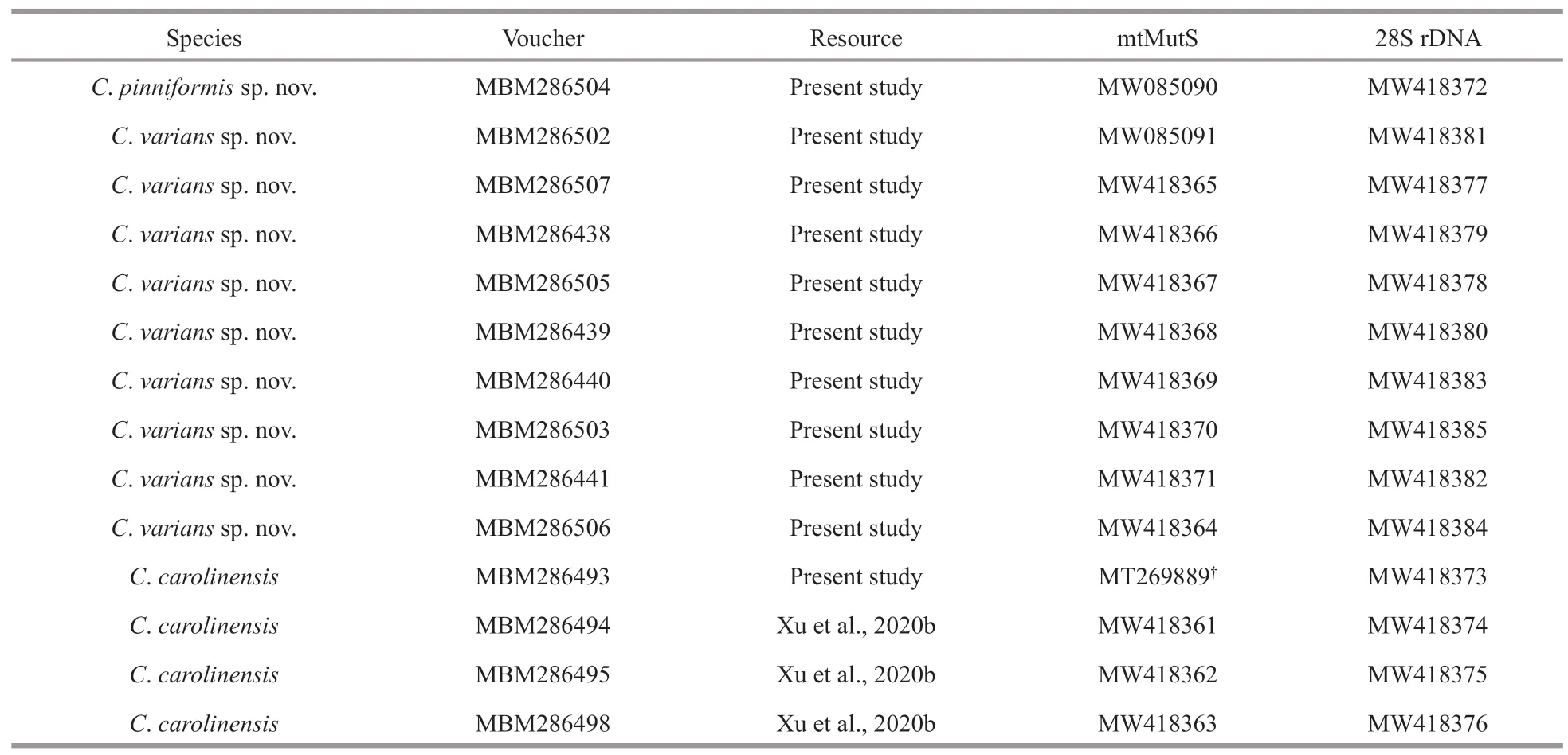
Table 1 New sequences in the present study
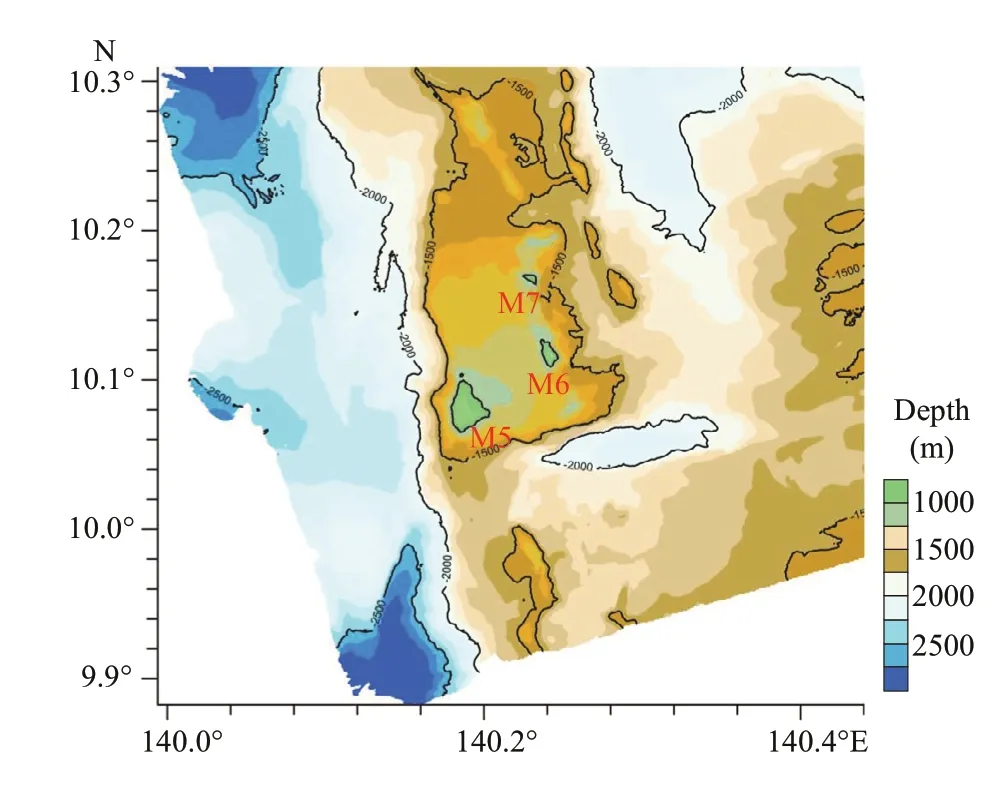
Fig.1 Sampling site on the Caroline seamounts (M5–M7) in the Western Pacific Ocean
A stereo dissecting microscope was used to examine the general morphology and anatomy.The preparation of sclerites for imaging followed Xu et al.(2020a).A TM3030Plus Scanning Electron Microscope (SEM) was used to obtain the SEM scans and the optimum magnification was chosen for each kind of sclerite.The morphological terminology used follows Bayer et al.(1983).
The type specimen of the new species has been deposited in the Marine Biological Museum of Chinese Academy of Sciences (MBMCAS) at Qingdao,China.
2.2 DNA extraction and sequencing
Genomic DNA was extracted from the polyps of the ten specimens using DNeasy Blood and Tissue Kit(Qiagen,Hilden,Germany) following instructions.The mitochondrial regionmutShomolog (mtMutS)and an approximately 750-nt fragment of the 28S nuclear ribosomal gene (28S rDNA) were selected for the phylogenetic analysis.To amplify mtMutS,the primers AnthoCorMSH (5ʹ-AGGAGAATTATTCTAAGTATGG-3ʹ;Herrera et al.,2010) and Mut-3458R(5ʹ-TSGAGCAAAAGCCACTCC-3ʹ;Sánchez et al.,2003) were used.PCR reactions were conducted following Xu et al.(2020a).We sequenced 28S rDNA using primers 28S-Far and 28S-Rar (McFadden and van Ofwegen,2013),and the same PCR protocol used for mtMutS.PCR purification and sequencing were performed by TsingKe Biological Technology(TsingKe Biotech,Beijing,China).
2.3 Genetic distance and phylogenetic analyses
All theChrysogorgiasequences and the related chrysogorgiid genera and out-group speciesChromoplexauramarki,Alaskagorgiaaleutiana,andPlexaurakunawere downloaded from GenBank.The sequences containing sequencing errors (usually marked with“n”or“y”) or from unclassified species(e.g.Chrysogorgiasp.) or without associated publications or from duplicate isolates were excluded from the molecular analyses.The sequences were aligned using MAFFT v.7 (Katoh and Standley,2013) with the G-INS-i and Q-INS-i algorithms for the mtMutS and 28S rDNA regions,respectively.The nucleotide alignment was trimmed to equal length using BioEdit v7.0.5 (Hall,1999).Genetic distances between species/populations were calculated with MEGA 6.0 using Kimura 2-parameter model (Tamura et al.,2013).
For the phylogenetic construction,when conspecific sequences were identical,one was chosen randomly for analysis.The best-fitted model GTR+G was selected with the Akaike information criterion in jModeltest2 (Darriba et al.,2012) for both the mtMutS and 28S rDNA alignments.Maximum likelihood(ML) analysis was performed using PhyML-3.1(Guindon et al.,2010).With node support from a majority-rule consensus tree of 1 000 bootstrap replicates.Following Hillis and Bull (1993),the ML bootstraps <70%,70%–94%,and ≥95% were considered as low,moderate and high,respectively.Bayesian inference (BI) analysis was carried out using MrBayes v3.2.7a (Ronquist and Huelsenbeck,2003).Posterior probability was estimated based on 10 000 000 Monte Carlo Markov Chain (MCMC)generations (×4 chains) sampling every 1 000 generations (burn-in=25%).Convergence of the MCMC was assessed using Tracer 1.4.1 (Rambaut and Drummond,2007).Following Alfaro et al.(2003),the Bayesian posterior probabilities <0.95 and≥0.95 were considered as low and high,respectively.
3 RESULT
3.1 Taxonomy
Class Anthozoa Ehrenberg,1834
Subclass Octocorallia Haeckel,1866
Order Alcyonacea Lamouroux,1812
Suborder Calcaxonia Grasshoff,1999
Family Chrysogorgiidae Verrill,1883
GenusChrysogorgiaDuchassaing &Michelotti,1864
Chrysogorgia pinniformis sp.nov.(Figs.2–4)
urn:lsid:zoobank.org:act:74FE8B57-1038-49CC-83E2-CF05BB27C544
Material examinedHolotype:MBM286504,station FX-Dive 218 (10°07ʹ48″N,140°14ʹ23″E),M6 seamount,1 002 m,6 June 2019.
DiagnosisChrysogorgiain Versluys’ group C(Squamosaetypicae) with a bushy colony.Large branches pinnately branched and forming multiple fans with its small branches regularly and quasidichotomous branched.Polyps nearly perpendicular to the branches,with tentacles expanded usually without contraction.Scales in the tentacle rachis transversely and obliquely arranged,branched with various shapes.Scales in pinnules longitudinally arranged,small and cuneate.Scales in polyp body wall longitudinally and transversely arranged,with a medial contraction.Scales and rods in mouth area of polyps longitudinally arranged,with many small warts on surface.Scales in coenenchyme elongate and longitudinally arranged.
DescriptionSpecimen of the holotype large,about 69-cm tall and 53-cm wide,including three main large branches (Fig.2b &c).Stem with a golden metallic luster,about 8 mm in diameter at base.The colony is made up of multiple,irregularly arranged fans.Each major branch zigzags and produces small lateral branches in an alternate pinnate manner.The lateral branches re-divide in a dichotomous or quasidichotomous manner,with distance between adjacent branches 3–6 mm and parallel branches 4–14 mm(Fig.2d).Branchlets diverge in an alternating opposite fashion and straight up to 45-mm long and bear up to 10 polyps,after which they terminate or continue to branch in a dichotomous fashion.Polyps about 2.0–2.5-mm long and 1-mm wide at base,sometimes thin and translucent,well spaced on branchlets (Figs.2d–e&3a).Polyps usually perpendicular to branchlets,arranged up to three in the branchlet internodes and up to eight in the larger branch internodes.No polyps present in the smallest internodes but a polyp present at each node.Tentacular part usually spread with eight obvious tentacles without contraction after collection,up to 2-mm long (Figs.2e &3a).
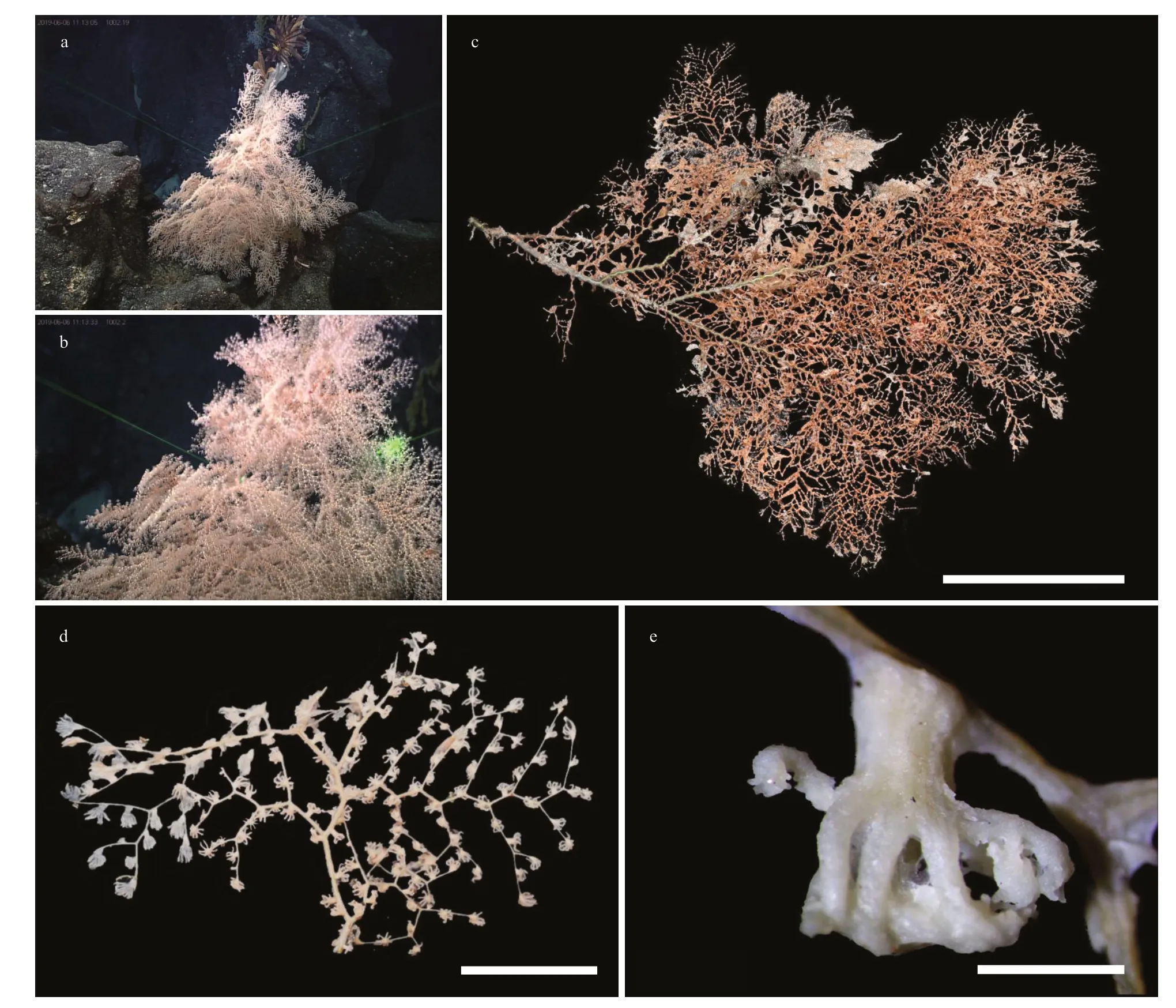
Fig.2 The external morphology and polyps of Chrysogorgia pinniformis sp.nov.
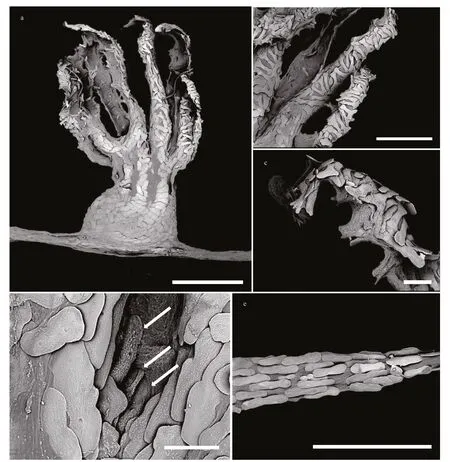
Fig.3 Polyp and coenenchyme of Chrysogorgia pinniformis sp.nov.under SEM
Sclerites with same forms and arrangements in nonterminal and terminal polyps in this species.Scales in polyp body wall longitudinally and obliquely arranged,smooth with an obvious medial contraction,measuring(54–231) μm×(29–142) μm (length×width,the same below,Figs.3a &4a).Scales in aboral region of tentacle rachis transversely and obliquely arranged,elongate,and branched with various shapes and relatively coarse surface,measuring (75–298) μm×(15–145) μm (Figs.3b &4b).Scales in pinnules longitudinally arranged,small and cuneate,measuring(74–232) μm×(15–58) μm (Figs.3c &4e).Scales in joint part between tentacle rachis and pinnules longitudinally arranged,usually branched,with one or both ends forked,sometimes extending onto the proximal part of the pinnule,measuring (92–151) μm×(35–61) μm (Figs.3c &4d).Scales and rods in mouth area on the outside of polyp body radially arranged,elongate and thick,both with many small conical and densely arranged warts on surface,measuring (70–238) μm×(15–52) μm (Figs.3d &4f).Scales in coenenchyme longitudinally arranged,elongate and often smooth,occasionally with a medial contraction,measuring (72–293) μm×(13–113) μm (Figs.3e &4c).Sclerites of some polyps sparse or rare.
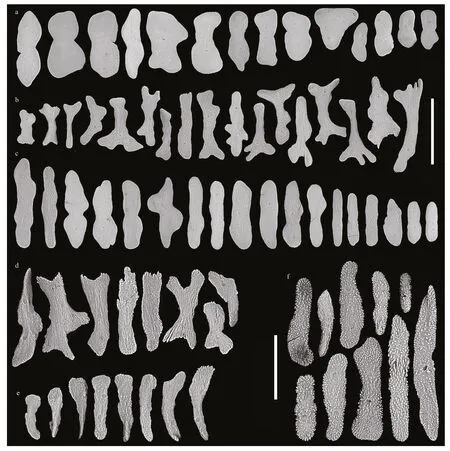
Fig.4 Sclerites of Chrysogorgia pinniformis sp.nov.
Type localityA seamount (tentatively named as M6) located on the Caroline Ridge with water depth of 1 692 m.
EtymologyThe Latin adjectivepinniformis(pinniform) refers to the pinnate branches of this colony.
Distribution and habitatFound from an unnamed seamount located on the Caroline Ridge in the tropical Western Pacific Ocean,where the water depth was 1 692 m,the water temperature about 4.85 °C and the salinity about 36.7.Colony very bushy in situ and attached to a rocky substrate (Fig.2a&b).
RemarksChrysogorgiapinniformissp.nov.belongs to Versluys’ group C (Squamosaetypicae)and is similar toC.electraBayer &Stefani,1988,C.scintillansBayer &Stefani,1988,andC.binataXu,Zhan &Xu,2019 by having some fan-shaped structure,but differs from them by having regular scales in polyp body wall (vs.irregular in all),and warty scales and rods present in the polyp (vs.absent in all).It differs from the species with a bottlebrushshaped colony (clockwise or counterclockwise) in theSquamosaetypicaegroup by being a bushy colony composed of multiple,irregularly arranged fans.Chrysogorgiapinniformissp.nov.is similar toC.japonica(Wright &Studer,1889) (unknown colony shape) by some dichotomous branching manner,but differs by scales in tentacle rachis (transversely and obliquely arranged,branched with various shapes vs.longitudinally arranged,rod-like with blunt ends,sometimes with a short fork at one end),and sclerites in coenenchyme (elongate scales vs.broad spindles with lancet-shaped bodies).Within the genusChrysogorgia,only the new species andChrysogorgiapinnataCairns,2007 possess pinnate branching.However,Chrysogorgiapinnatabelongs to the Versluys’ group A (Spiculosae).
Chrysogorgia varians sp.nov.(Figs.5–13;Tables 2 &3)
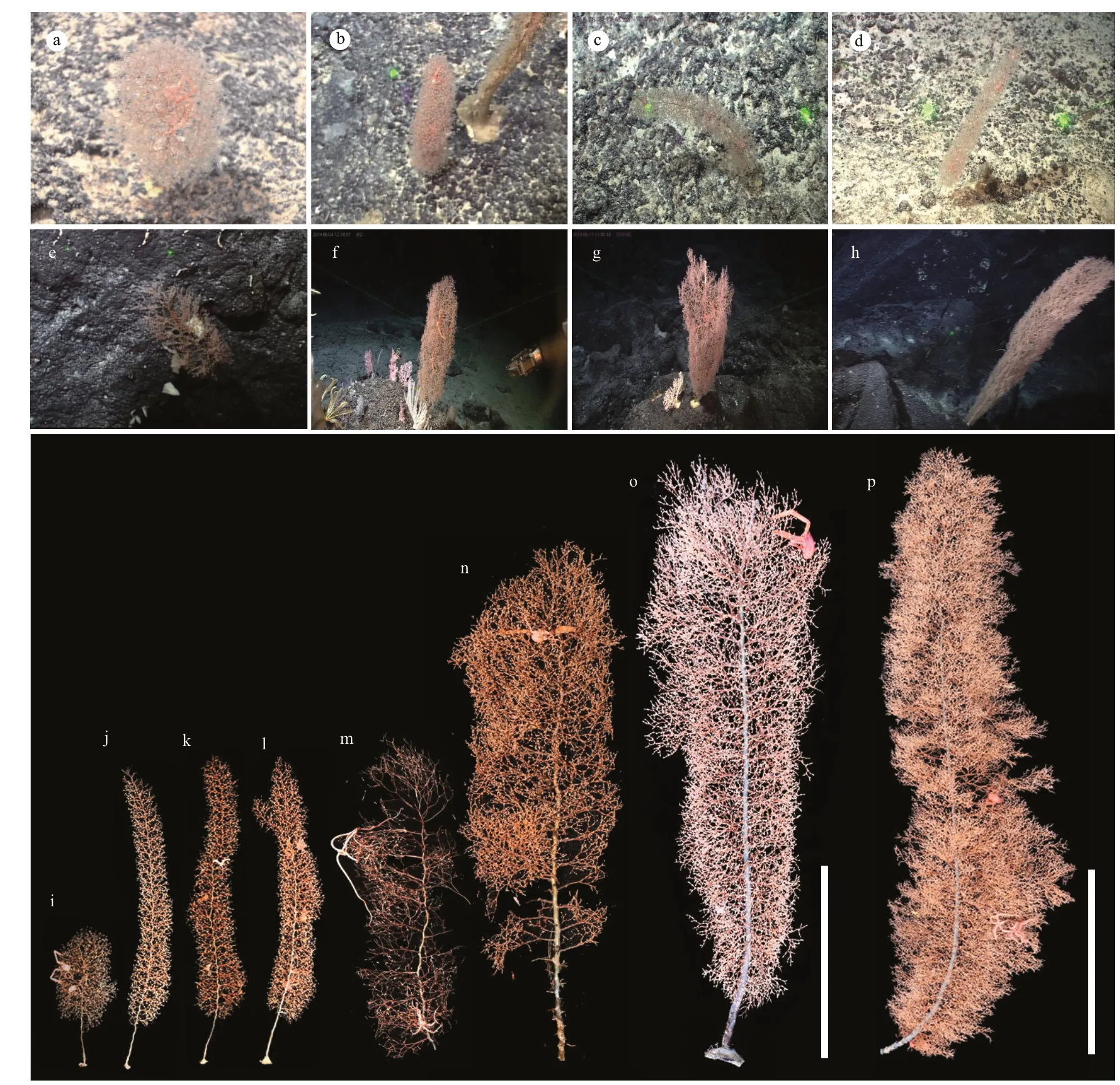
Fig.5 The external morphology of Chrysogorgia varians sp.nov.
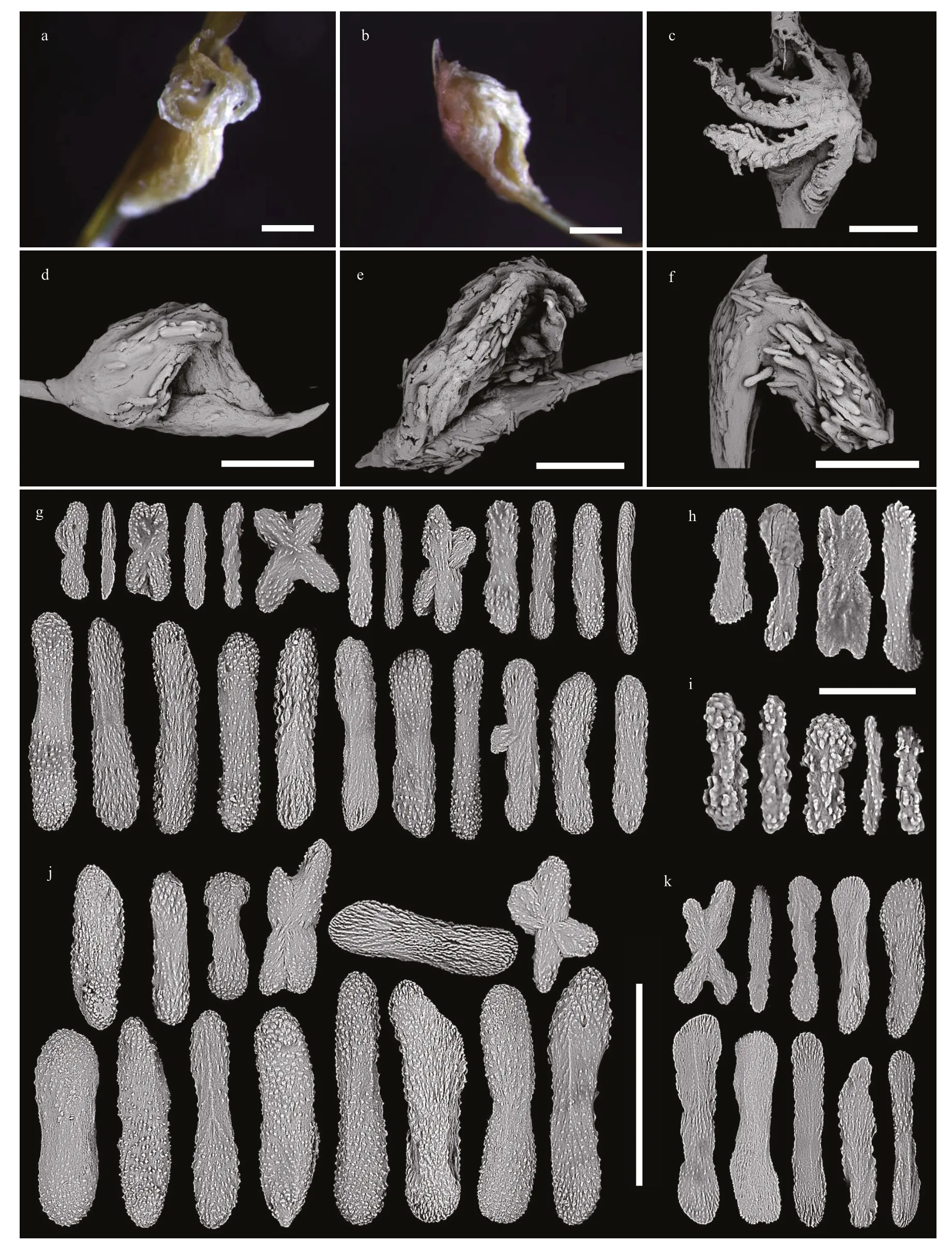
Fig.6 Polyps and sclerites of C.varians sp.nov.(MBM286503)
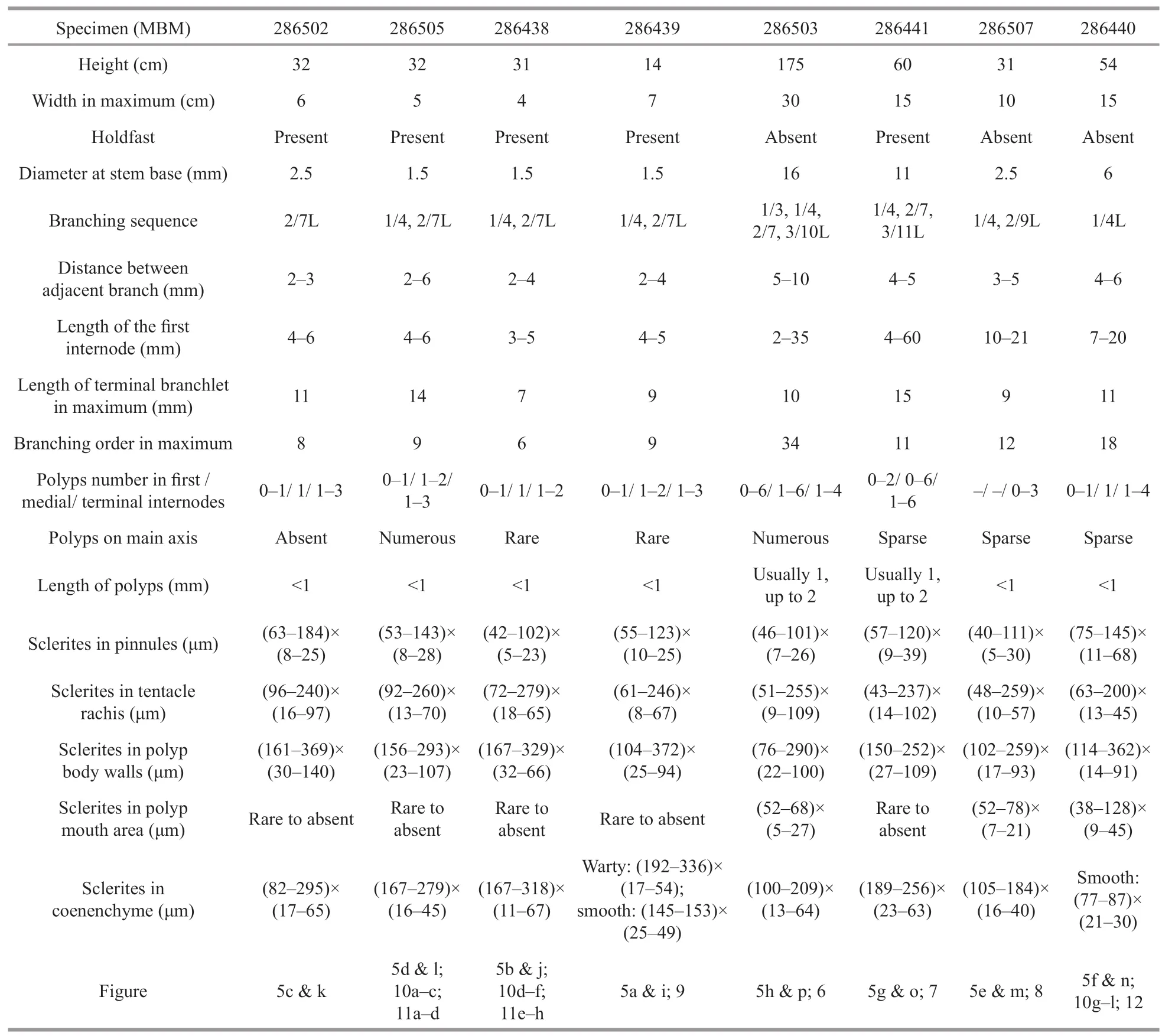
Table 2 The external morphological data of the relatively complete specimens of Chrysogorgia varians sp.nov.
urn:lsid:zoobank.org:act:96111211-8D7B-40EFBFF4-1A2D78DE5247
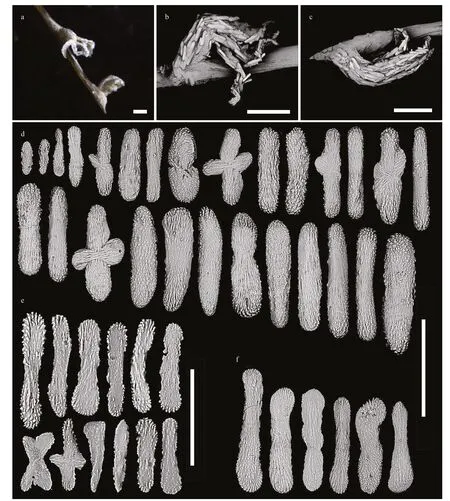
Fig.7 Polyps and sclerites of C.varians sp.nov.(MBM286441)
Material examinedHolotype:MBM286503,station FX-Dive 217 (10°06ʹ49″N,140°15ʹ00″E),M6 seamount,1 145 m,5 June 2019;Paratypes:MBM286502,station FX-Dive 213 (10°04ʹ35″N,140°11ʹ25″E),M5 seamount,832 m,31 May 2019;MBM286505,station FX-Dive 210 (10°04ʹ41″N,140°12ʹ04″E),M5 seamount,911 m,28 May 2019;MBM286506,station FX-Dive 210 (10°04ʹ40″N,140°11ʹ57″E),M5 seamount,884 m,28 May 2019;MBM286507,station FX-Dive 211 (10°03ʹN,140°10ʹE),M5 seamount,1384–1 482 m,29 May 2019;MBM286438,station FX-Dive 213 (10°04ʹ28″N,140°11ʹ36″E),M5 seamount,899 m,31 May 2019;MBM286439,station FX-Dive 215 (10°04ʹ44″N,140°11ʹ04″E),M5 seamount,865 m,2 June 2019;MBM286440,station FX-Dive 216 (10°05ʹ23″N,140°11ʹ12″E),M5 seamount,902 m,4 June 2019;MBM286441,station FX-Dive 223 (10°04ʹ38″N,140°15ʹ08″E),M7 seamount,1 071 m,11 June 2019.

Fig.8 Polyps and sclerites of Chrysogorgia varians sp.nov.(MBM286507)
DiagnosisChrysogorgiain Versluys’ group A(Spiculosae) with a bottlebrush-shaped colony and a varied branching sequence in different growth stages.Branches subdivided dichotomously,occasionally anastomose in some old branches.Polyps are small with tentacles extended or not visible.Rods in aboral face of tentacle rachis longitudinally arranged,regular with many small conical or ridge-like warts on surface and two rounded ends.Scales in pinnules and the end of tentacles usually longitudinally arranged,slender and often having many warts and ridges,and conspicuously toothed margins at the rounded ends,occasionally nearly smooth and with irregular shape.Rods in polyp body wall same as those of tentacle rachis,longitudinally or obliquely arranged,some of them relatively larger than those in tentacles.Rods near the polyp mouth area rare to absent,small and usually with elongate and ridge-like warts.Scales in coenenchyme at the base of polyps slender and a little coarser with more or less conical warts on surface,and in inter-polyps rare to absent,occasionally smooth with two rounded ends,all of them longitudinally and obliquely arranged.
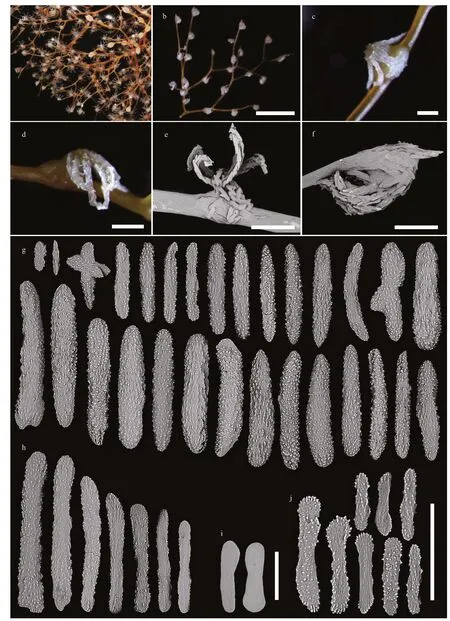
Fig.9 Polyps and sclerites of Chrysogorgia varians sp.nov.(MBM286439)
DescriptionSpecimen of the holotype having a large bottlebrush-shaped colony,about 175-cm tall and 30-cm wide,with the holdfast not recovered(Fig.5h &p).Stem about 16 mm in diameter at base.Branching sequence irregular,including 1/3L,1/4L,2/7L,and 3/10L.Distance between adjacent branch about 5–10 mm,and the first internode of branch up to 35-mm long.Branches subdivided dichotomously,up to 34 orders,occasionally irregular in some old branches.Polyps small,usually 1-mm long,sometimes up to 2 mm,with tentacles extended or not visible and forming a conical shape (Fig.6a–f).Sometimes the oral region is angled,upwards or towards the periphery,rarely downwards (Fig.6c).Polyps usually zero to six on first internode,up to six in the other internodes.Polyps on the main axis are small and numerous,and nematozooids are absent.
Rods in aboral face of tentacle rachis longitudinally arranged,regular with many small warts on surface and two rounded ends,rarely with one sharp end,some of them crosses,measuring (51–255) μm×(9–109) μm (Fig.6g).These warts usually conical and densely arranged,sometimes large and ridge-like,and longitudinally or transversely arranged on the sclerites surface.Scales in pinnules and the end of tentacles usually longitudinally arranged,sparse,small and slender,often having many warts and ridges and conspicuously toothed margins at the rounded ends,occasionally nearly smooth and with irregular shape,measuring (46–101) μm×(7–26) μm (Fig.6h).The warts on the surface of the pinnule’s scales commonly elongate and ridge-like,sometimes in rows.Rods in polyp body wall same as those of tentacles rachis,longitudinally or obliquely arranged,some of them relatively larger and stout with more blunt ends,measuring (76–290) μm×(22–100) μm (Fig.6j).Rods in the polyp mouth area rare to absent,small with many warts on surface,measuring (52–68) μm×(5–27) μm (Fig.6i).These warts usually elongate and ridge-like,sometimes cylindrical or conical,arranged relatively densely and sometimes in rows.Scales usually present in coenenchyme at the base of terminal polyp,while rare to absent in other polyps,longitudinally and obliquely arranged.Scales in coenenchyme at the base of polyps slender and a little coarser with more or less conical warts on surface,and in inter-polyps rare to absent,some of them almost smooth with two rounded ends,measuring(100–209) μm×(13–64) μm (Fig.6k).
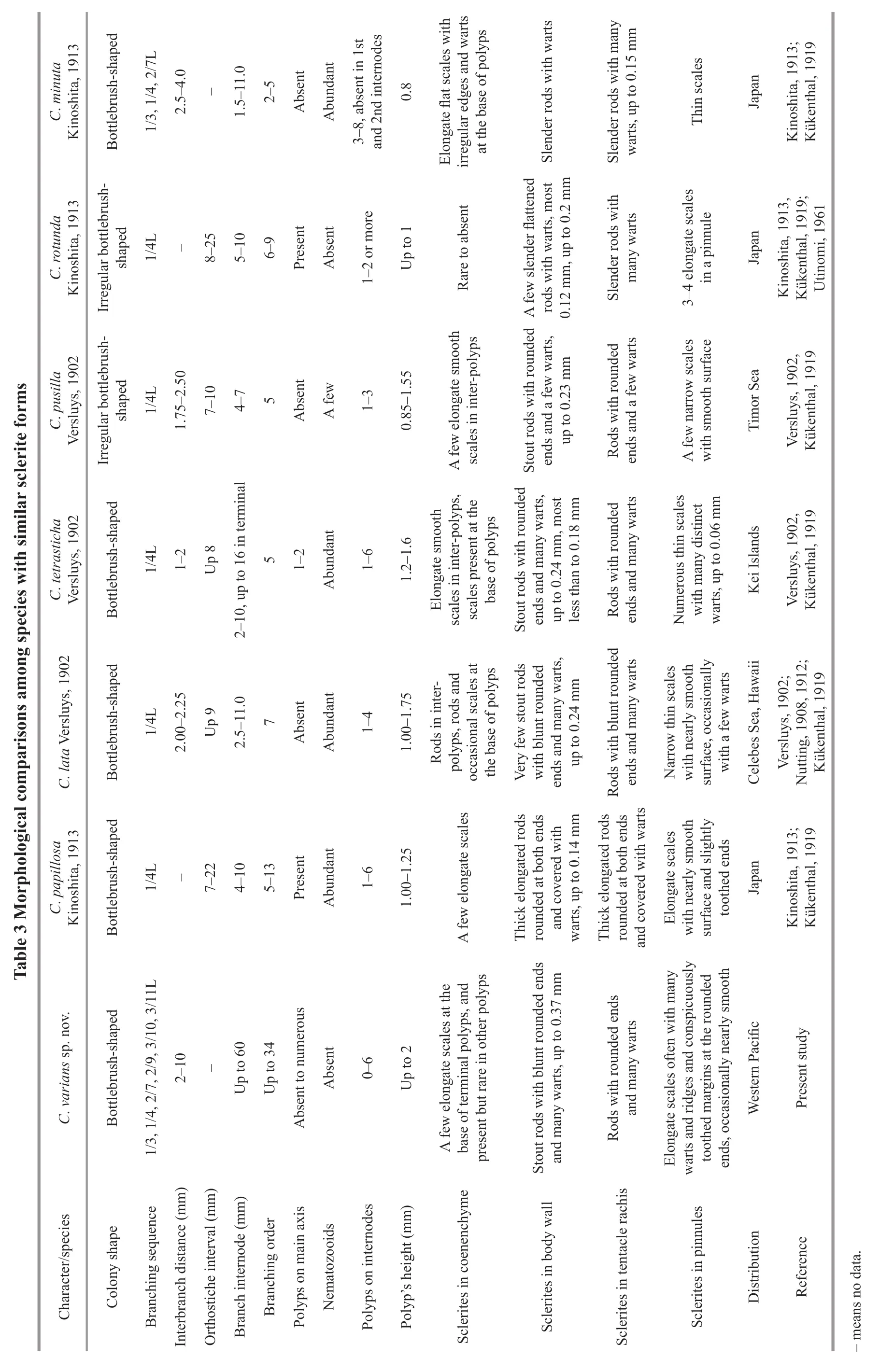
Variation of paratypeThe specimens of paratype have relatively complete colony except the specimen MBM286506.For their morphological measurements,see Table 2.There are some differences compared with the holotype,such as varied branching sequence,polyp’s size,and numbers in internodes,and the length of the first internode (Table 2).Some another differences among them include:the polyps of specimens MBM286502,MBM286505,and MBM286438 usually form a conical or columnar shape (Fig.10a &d);the branches of the specimen MBM286440 are more irregular and occasionally anastomose in some old branches (Fig.10g);the specimen MBM286507 was possibly dying when it was collected with a few polyps and almost exposed branches (Fig.5m);the numbers of the sclerites in pinnules are more sparse in the holotype;the sclerites in polyp mouth area are rare in specimens MBM286502,MBM286505,MBM286438,MBM286439,and MBM 286441;the sclerites in the coenenchyme at the base of terminal polyps are more slender and coarse in specimen MBM286502,MBM286505,MBM286438,and MBM286439 (Figs.9 &11);the sclerites in polyps are more slender in specimen MBM286440 (Fig.12).
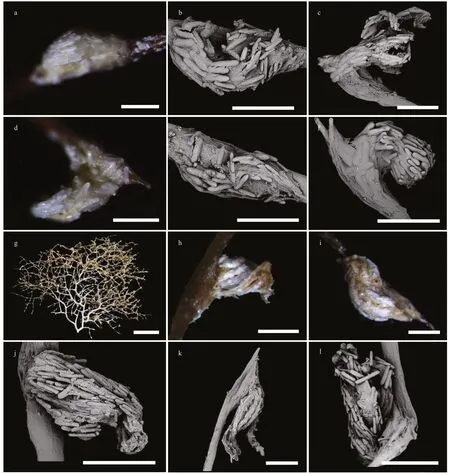
Fig.10 Branches and polyps of Chrysogorgia varians sp.nov.
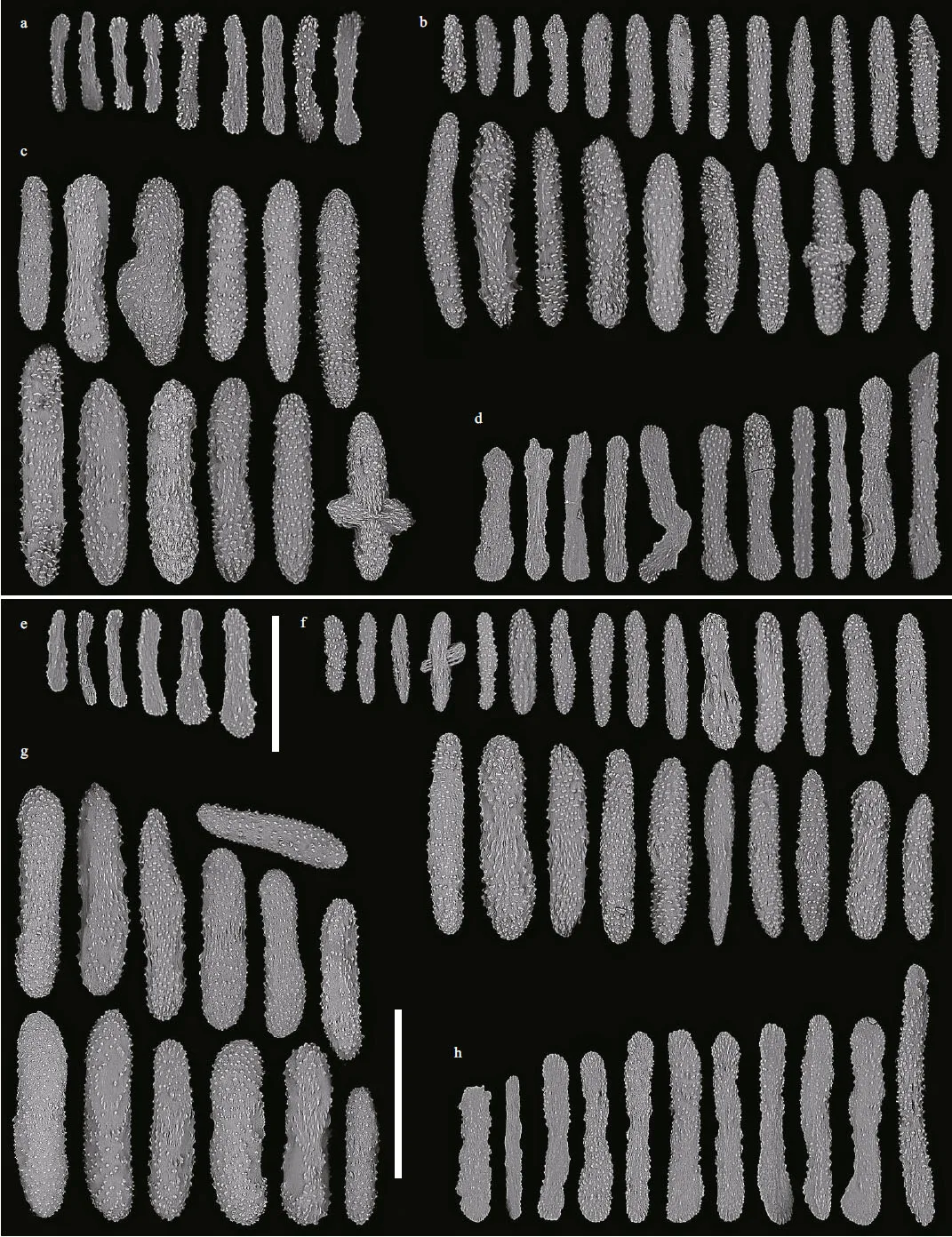
Fig.11 Sclerites of Chrysogorgia varians sp.nov.
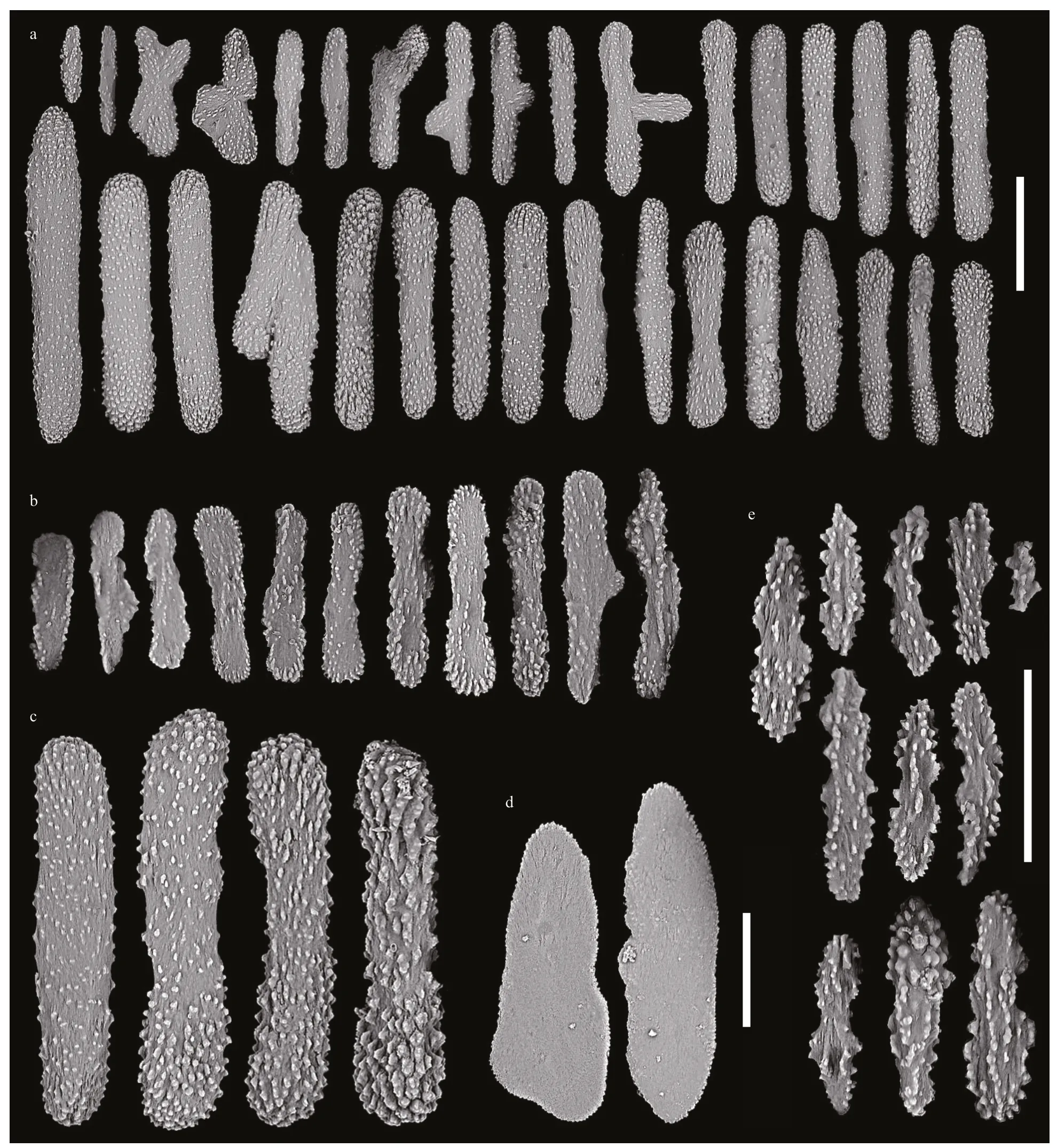
Fig.12 Sclerites of Chrysogorgia varians sp.nov.(MBM286440)
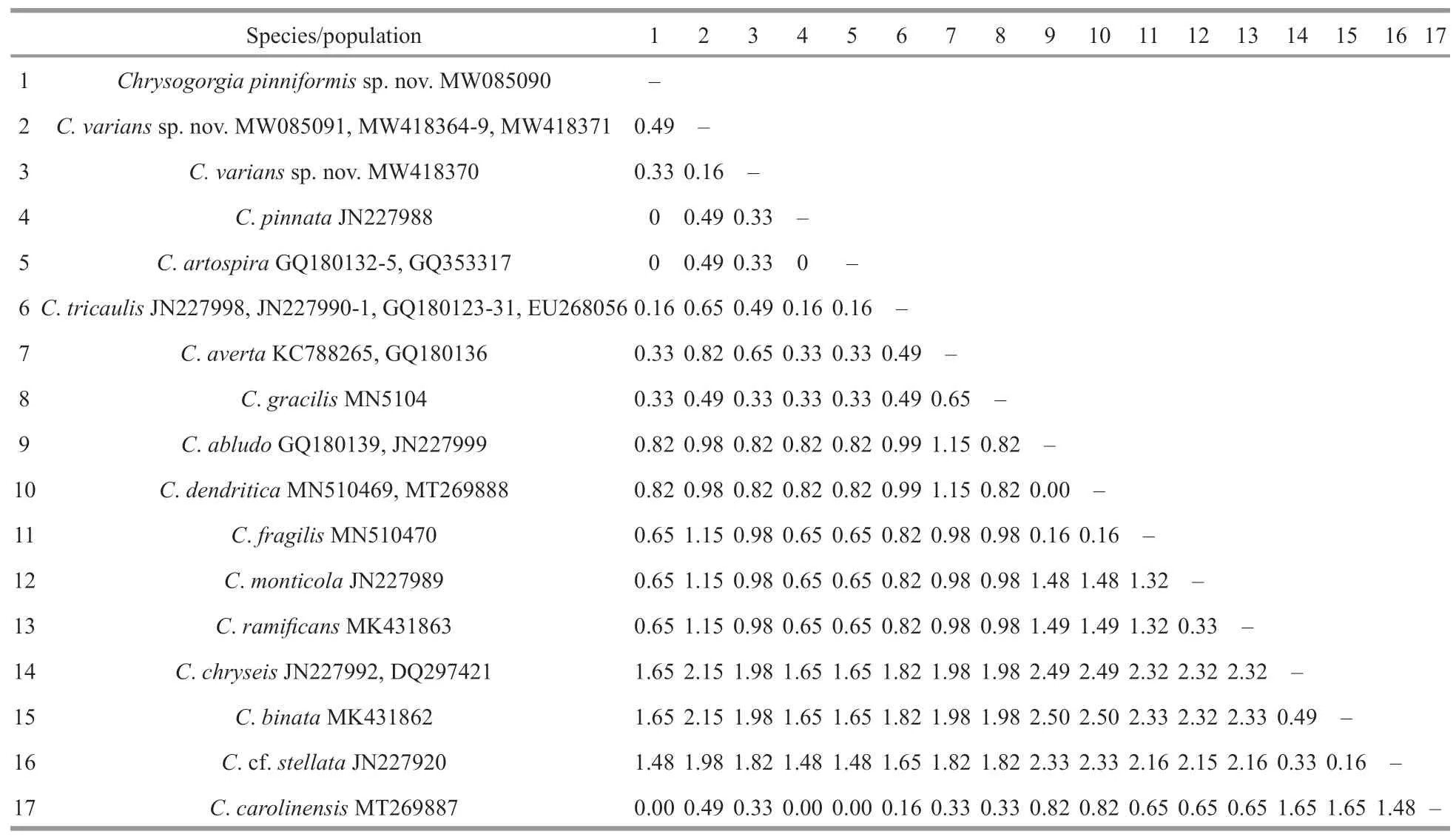
Table 4 Interspecific and intraspecific distances at mtMutS of Chrysogorgia species (in %)
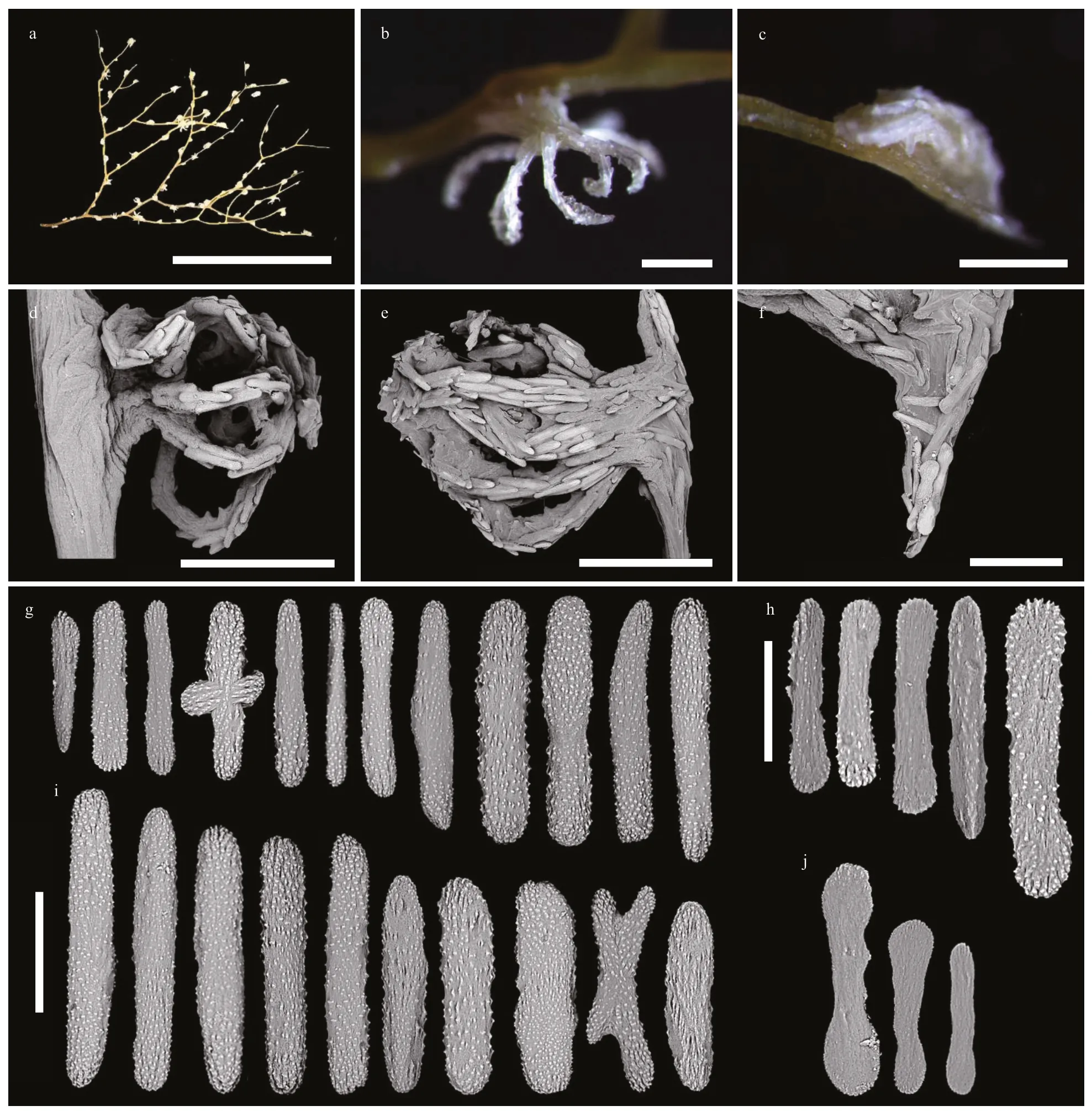
Fig.13 Polyps and sclerites of Chrysogorgia varians sp.nov.(MBM286506)
Type localityA seamount (tentatively named as M6) located on the Caroline Ridge with water depth of 1 145 m.
Distribution and habitatFound from the Caroline seamounts (tentatively named as M5–M7)with water range of 832–1 482 m.Colonies attached to rocky substrate.The water temperatures were about 4.13–5.27 °C and the salinity about 36.6–36.8.
EtymologyThe Latin adjectivevarians(varied)refers to the varied branching sequence in different growth stages of this species.
RemarksChrysogorgiavarianssp.nov.belongs to Versluys’ group A (Spiculosae) with a bottlebrushshaped colony.It is characterized by warty rods and elongate scales in the tentacles,scales often with many warts and ridges and conspicuously toothed margins at the rounded ends in the pinnules,and small rods with elongate and ridge-like warts in the polyp mouth area.The nine specimens collected from the Caroline seamounts all have a bottlebrush-shaped colony and the same sclerite forms (Figs.5–13).Thus,we identified them as the same species.As mentioned above,there are some differences among the nine specimens ofC.varianssp.nov.However,these character differences are not constant and may be caused by different growth stage or environment or inadequate measurement,and we thus treated as the intraspecific variation.
The sclerite forms and branching sequences ofC.varianssp.nov.are similar toC.papillosaKinoshita,1913 andC.minutaKinoshita,1913 but it differs fromC.papillosaby scales in pinnules often with many warts and ridges on surface (vs.nearly smooth),large stout rods in polyp body wall (up to 0.37 mm vs.small,thick and elongated rods,up to 0.14 mm),small warty rods present in the mouth area of polyps (vs.absent) and nematozooids absent in polyps and branches (vs.abundant) (Kinoshita,1913)(Table 3).Chrysogorgiavarianssp.nov.can be separated withC.minutaby larger and wider rods in polyps (vs.relatively small and slender),elongate scales with less warts on surface at the base of polyps(vs.stout with many warts and irregular outlines) and small warty rods present in the mouth area of polyps(vs.absent) (Kinoshita,1913) (Table 3).It is also similar toC.lataVersluys,1902 andC.tetrastichaVersluys,1902,but differs from the former by rare scales in coenenchyme between polyps (vs.rare rods),elongate scales in the tip of tentacles (vs.rods),and small warty rods present in the mouth area of polyps(vs.smooth scales),and from the latter by scales in pinnules (relatively large,often with many warts and ridges and conspicuously toothed margins at the rounded ends vs.small and without ridges and conspicuously toothed margins),and small warty rods present in the mouth area of polyps (vs.absent)(Table 3).
3.2 Genetic distance and phylogenetic analyses
The new sequences were deposited in GenBank(Table 1).The alignments comprised 623 and 647 nucleotide positions for the mtMutS and 28S rDNA regions,respectively.Based on the mtMutS aligned region,no intraspecific variability was observed,and the interspecific distances range from zero to 2.44%for theChrysogorgia(Table 4).For mtMutS,the genetic distances between the new speciesC.pinniformissp.nov.and 15 of its congeners are in the range of 0–1.65%,and those betweenC.varianssp.nov.and 15 of its congeners are in the range of 0.33%–2.15% (Table 4).Unlike the mtMutS database,only 28S rDNA sequences of four identifiedChrysogorgiaspecies are available,and the intraspecific data were obtained from onlyC.carolinensisandC.varianssp.nov.(Table 5).The intraspecific distances were in range of 0.16%–1.64%forC.carolinensisand 0–1.65% forC.varianssp.nov.,while the interspecific distances ranged from 5.95% to 17.90% (Table 5).
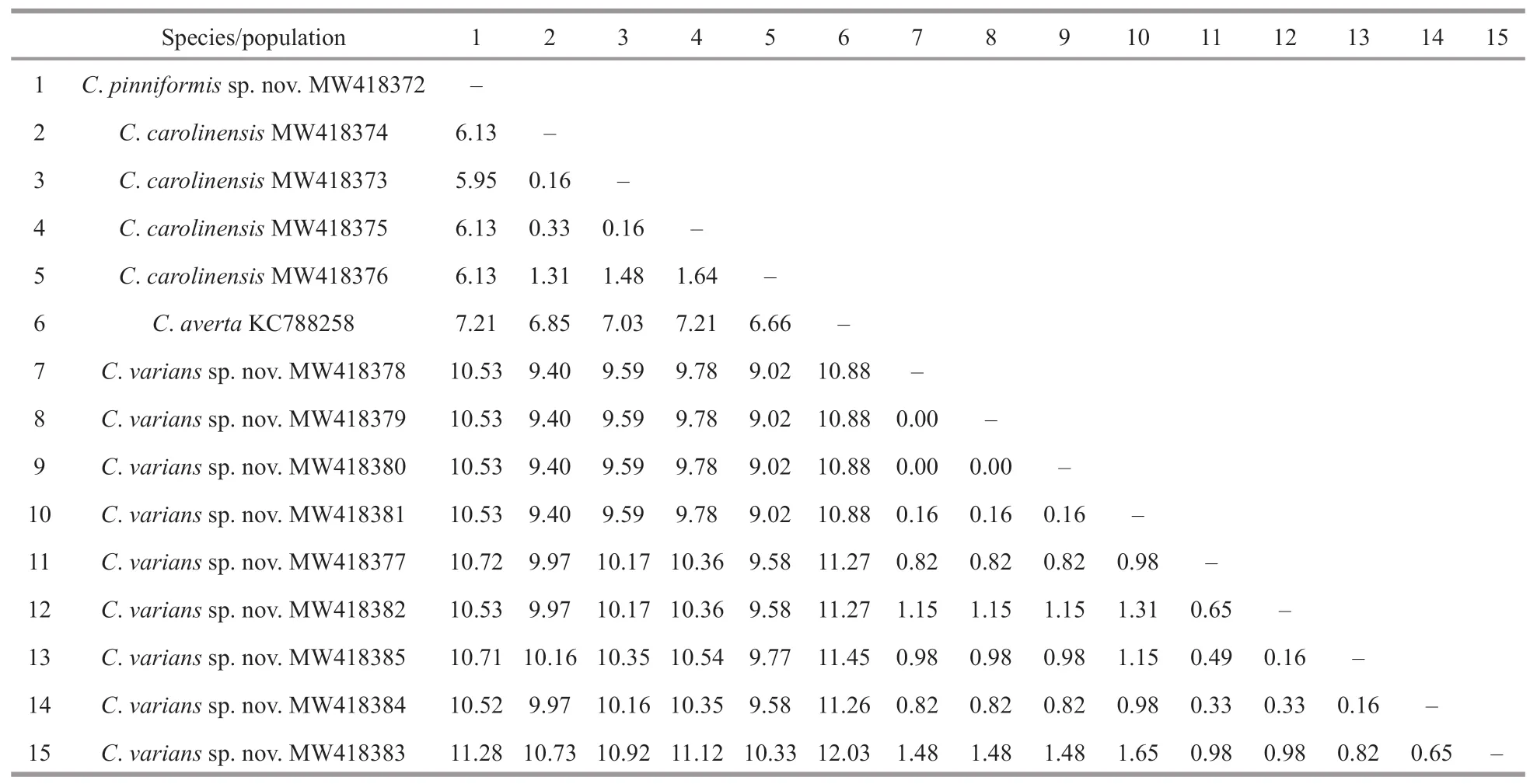
Table 5 Interspecific and intraspecific distances at 28S rDNA of Chrysogorgia species (in %)
The ML tree is nearly identical with the BI tree in topology for both the mtMutS and 28S rDNA regions,and thus a single tree with both support values was shown for each of the markers (Fig.14 &Supplementary Fig.S1).The two new species nested into theChrysogorgiaclade in both of the mtMutS and 28S rDNA trees with low to high support.In the mtMutS tree,all theChrysogorgiaspecies formed two main sister clades (Clade I and II) with moderate support,but most phylogenetic relationships within the two main clades were not resolved (Supplementary Fig.S1).In the 28S rDNA trees,all theChrysogorgiaspecies formed a monophyletic clade,and all the conspecific specimens clustered together with high support (ML 97%–100%;BI 1.00).Chrysogorgiavarianssp.nov.andC.carolinensisformed a sister clade to the groupC.pinniformissp.nov.+Chrysogorgiidae sp.KP324611 with low support(Fig.14).
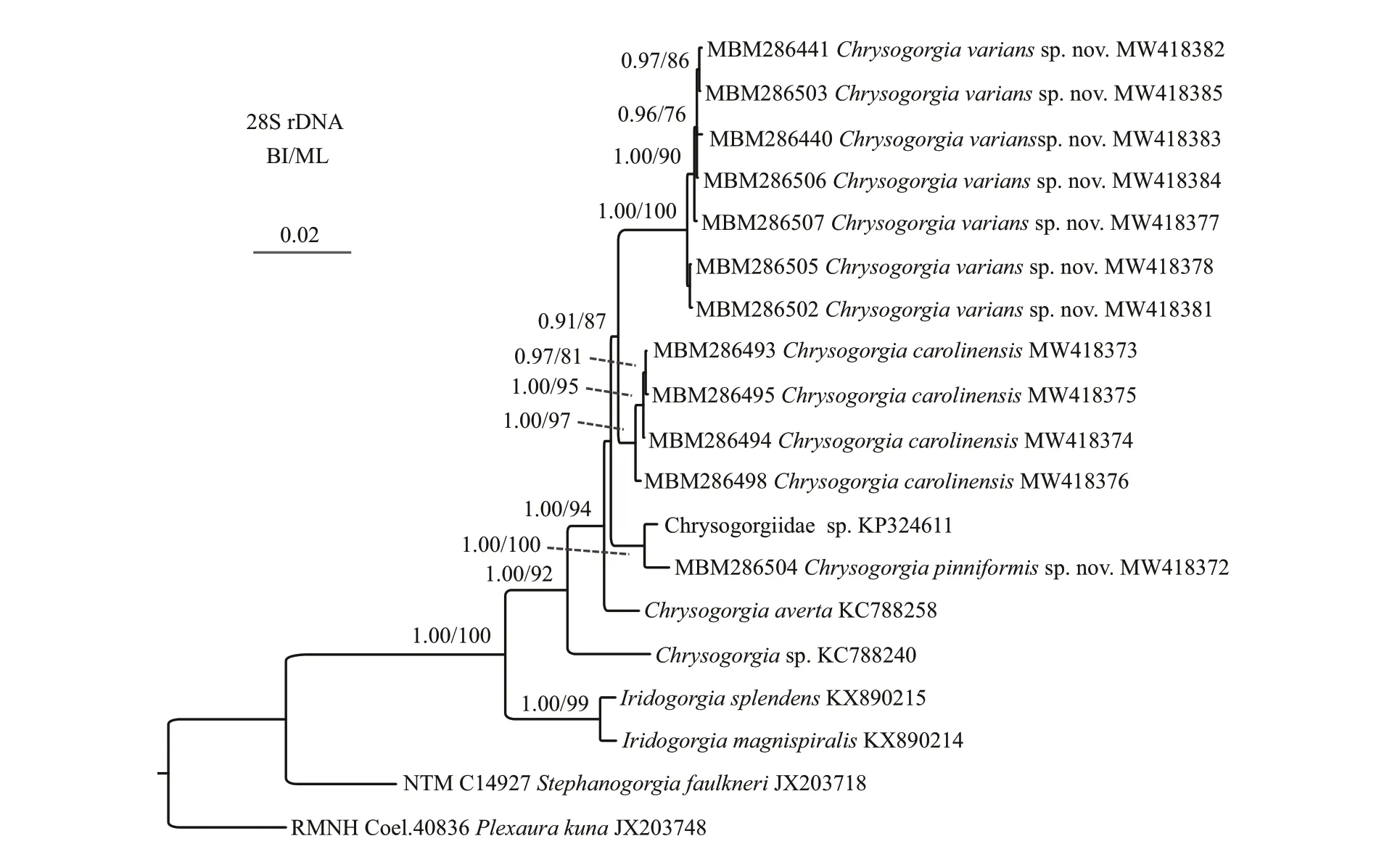
Fig.14 Bayesian inference (BI) tree constructed by 28S rDNA showing phylogenetic relationships among Chrysogorgia species
4 DISCUSSION
The assignment of the new species to the genusChrysogorgiawas supported by the morphology and molecular phylogenetic analysis.The mtMutS region is one of the most commonly used makers in an integrative identification of octocorals (McFadden et al.,2011;McFadden and van Ofwegen,2013;Xu et al.,2019,2020a,b).However,there is no barcoding gap for delimitatingChrysogorgiaspecies,and,additionally,no genetic variability was observed amongC.pinniformissp.nov.,C.carolinensis,C.pinnata,andC.artospira,indicating its very limited usefulness for species delimitation (Table 4).In contrast,the 28S rDNA showed higher level of genetic variation (e.g.interspecific distances 5.95–12.03 vs.0–2.5 at mtMutS).The 28S rDNA genetic distances amongC.varianssp.nov.specimens were in the range of 0–1.65,similar to the intraspecific distances ofC.carolinensis(0.16–1.64),supporting the conspecific assignment of thevarians-like specimens.Although only 28S rDNA sequences of fourChrysogorgiaspecies are available,the present distance analysis indicated the 28S rDNA region as a potential barcode for this genus.The genetic distances betweenC.varianssp.nov.and the congeners are relatively higher (in range of 0.33–0.49 at mtMutS),confirming its validity.
It is worth noting that the specimens ofC.varianssp.nov.have different morphological features,such as the varied branching sequence,polyp’s shape,size and numbers in internodes,and the length of the first internode (Table 2).Considering the diameter of stem base,branching order,and the colony size,these specimens showed a series of growth stages:the specimen MBM286438,MBM286439,MBM286502,and MBM286505 are likely juveniles with narrow stem base,less branching order and short colonial height,and MBM286507 is likely an intermediate state,while MBM286441,MBM286443,and MBM286503 are likely adults with the wider stem base,more branching order,and higher colonial height.Therefore,the branching sequence ofC.varianssp.nov.often shows 1/4 and 2/7L in juveniles,and becomes more and more irregular (1/3,1/4,2/7,2/9,3/10,3/11L) with continued growth.The lengths of the first internode are short (3–6 mm) in juvenile,and gradually becomes longer and longer from bottom to top which can up to 60 mm.The polyps are usually small (less than 1 mm) and few in number (1–3) in the internodes of the juveniles,while they can be up to 2 mm and up to 6 in the internodes of the old specimens.Furthermore,the numbers of sclerites in the pinnules,polyp mouth area,and the coenenchyme at the base of polyps are also different,but they both have same forms in the same part of the different specimens.Consequently,compared to the changing external morphological features,the sclerite forms show small variation in the growth stages and can be used as a main character to identify the species(Xu et al.,2020b).
Branching sequence as a relatively constant trait is often used as a diagnostic character for a species ofChrysogorgia(e.g.Cairns,2001;Pante and Watling,2012).It is known to be varied in some species,however,even within a single specimen due to the different growth stage and environment,likeC.herdendorfiCairns,2001 (2/5R–3/8R),C.intermediaVersluys,1902 (1/4R–1/7R),C.squamata(Verrill,1883) (1/5R–1/7R),C.minutaKinoshita,1913 (1/3L,1/4L,2/7L),C.abludoPante &Watling,2012 (1/3L,1/4L,irregular) and the speciesC.varianssp.nov.described here (Untiedt et al.,2021).It is almost certain that it varies in many other species,especially those established colony fragments,but has gone unnoticed.Furthermore,as mentioned above,the features like polyp’s shape,size,and numbers in internodes,and the length of internode are also affected by the different growth stage and environment.Therefore,all of these features can be a secondary characteristic to help species identification,and the sclerites should be considered first (Xu et al.,2020b).In addition,it means there will be many synonyms inChrysogorgia,which needs more new specimens and molecular data to support and verify,then revise this genus.
Including the new species here,the genusChrysogorgiacontains 78 species.Among them,53 species are found only from the Pacific,17 species from the Atlantic and seven only from the Indian Ocean,andChrysogorgiaflexilis(Wright &Studer,1889) from both the Pacific and Indian Oceans(Cairns,2001,2018;Xu et al.,2019,2020a,b).In the joining area of Indo-West Pacific,there are 42 species recorded,including 20 species (C.bracteata,C.geniculata,C.rigida,C.ramosa,C.axillaris,C.cupressa,C.tetrasticha,C.sibogae,C.pendula,C.lata,C.mixta,C.calypso,C.chryseis,C.anastomosans,C.orientalis,C.curvata,C.pentasticha,C.octagonos,C.intermedia,andC.pusilla) from the Malay Archipelago,14 species(C.dispersa,C.pyramidalis,C.rotunda,C.papillosa,C.minuta,C.okinosensis,C.comans,C.sphaerica,C.debilis,C.pellucida,C.versluysi,C.excavata,C.japonica,andC.cavea) from the Japanese waters,and eight species (C.ramificans,C.binata,C.dendritica,C.fragilis,C.gracilis,C.carolinensis,C.pinniformis,andC.varians) that we recently described from the tropical Western Pacific (Watling et al.,2011,Xu et al.,2020b).The high species richness (42 of 78 in total) indicates that the Indo-West Pacific convergent region is a possible hotspot of deep-waterChrysogorgiaspecies.
5 CONCLUSION
Based on the morphological and phylogenetic analyses,ten sampled specimens ofChrysogorgiain Caroline seamounts are recognized as two new speciesChrysogorgiapinniformissp.nov.andChrysogorgiavarianssp.nov.Chrysogorgiapinniformissp.nov.is similar toC.pinnataCairns,2007 by the pinnate branching,but differs from the latter being in Versluys’ group C,Squamosaetypicaegroup (vs.Versluys’ group A,Spiculosae) and has sclerites present in the mouth area of polyps.Chrysogorgiavarianssp.nov.belongs to theChrysogorgiagroup A (Spiculosae) and shows morphological variability during different growth period.Additionally,it is found that the mtMutS marker showed very limited usefulness for species delimitation ofChrysogorgia,while the 28S rDNA region may a potential barcode for this genus.
6 DATA AVAILABILITY STATEMENT
The specimens described in this study are available at the Marine Biological Museum of Chinese Academy of Sciences (MBMCAS) at Institute of Oceanology,Qingdao,China.Voucher IDs:Chrysogorgiapinniformissp.nov.:MBM 286504;Chrysogorgiavarianssp.nov.:MBM286438,MBM286439,MBM286440,MBM286441,MBM286502,MBM286503,MBM286505,MBM286506,MBM286507.The mtMutS sequences that support the findings of this study have been deposited in NCBI GenBank with the accession codes MW085090 (Chrysogorgiapinniformis),MW085091,MW418365,MW418366,MW418367,MW418368,MW418369,MW418370,MW418371,MW418364(Chrysogorgiavarianssp.nov.) and MW418361,MW418362,MW418363 (ChrysogorgiacarolinensisXu,Zhan &Xu,2020).The 28S rDNA sequences that support the findings of this study have been deposited in NCBI GenBank with the accession codes MW418372 (C.pinniformissp.nov.),MW418381,MW418377,MW418379,MW418378,MW418380,MW418383,MW418385,MW418382,MW418384(C.varianssp.nov.) and MW418373,MW418374,MW418375,MW418376 (C.carolinensis).
The new species registration ofChrysogorgiapinniformissp.nov.andChrysogorgiavarianssp.nov.in Zoobank with LSID:urn:lsid:zoobank.org:act:74FE8B57-1038-49CC-83E2-CF05BB27C544 and urn:lsid:zoobank.org:act:96111211-8D7B-40EFBFF4-1A2D78DE5247,respectively.The publication LSID:urn:lsid:zoobank.org:pub:5C0EA878-ACF4-453A-9918-F4872AFA73E1.
7 ACKNOWLEDGMENT
We thank assistance of the crew of R/VKexue(Sciencein Chinese) and ROVFaxian(Discoveryin Chinese) for sample collection.Special thanks go to Mr.Shaoqing WANG for taking the photos onboard.
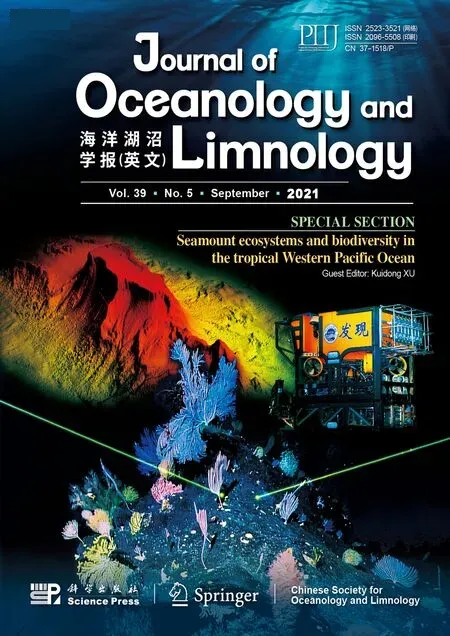 Journal of Oceanology and Limnology2021年5期
Journal of Oceanology and Limnology2021年5期
- Journal of Oceanology and Limnology的其它文章
- Screening of stable internal reference genes by quantitative real-time PCR in humpback grouper Cromileptes altivelis*
- Morphology and multifractal features of a guyot in specific topographic vicinity in the Caroline Ridge,West Pacific*
- Geochemical characteristics and geological implication of ferromanganese crust from CM6 Seamount of the Caroline Ridge in the Western Pacific*
- Deep-sea coral evidence for dissolved mercury evolution in the deep North Pacific Ocean over the last 700 years*
- Physical oceanography of the Caroline M4 seamount in the tropical Western Pacific Ocean in summer 2017*
- Characteristics and biogeochemical effects of oxygen minimum zones in typical seamount areas,Tropical Western Pacific*
